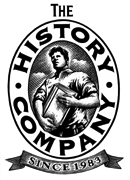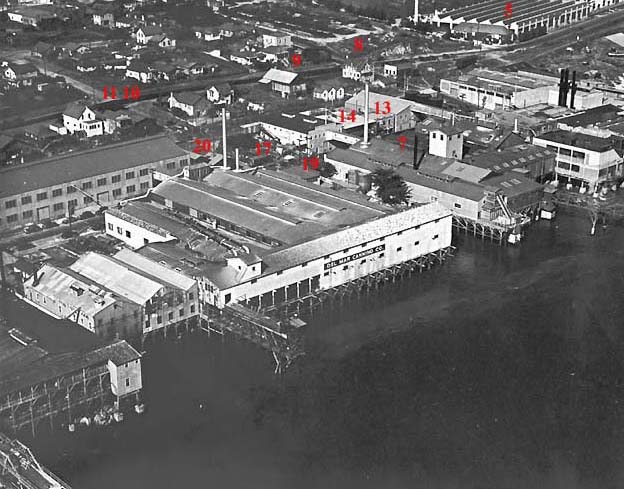
Research Materials
The real Cannery Row neighborhood in John Steinbeck's "Cannery Row"

Ted McKay aerial photo c.1938 from the Hathaway Collection of California Views

The real Cannery Row neighborhood in John Steinbeck's "Cannery Row"

Ted McKay aerial photo c.1938 from the Hathaway Collection of California Views
This late 1930s Ted McKay photo from the Hathaway Collection contains essentially the entire Cannery Row neighborhood described in John Steinbeck's "Cannery Row". John describes this neighborhood in detail in his opening chapters and many of its sites remain in existence today.
The numbers used in this index correspond to the index of locations contained in
"CANNERY ROW, The History of John Steinbeck's Old Ocean View Avenue"
Index to John Steinbeck's Cannery Row Neighborhood
11. The Joss House from China Point's early Chinese settlement. Due to its distance from the main part of the settlement it escaped destruction in the fire of 1906 that devastated the Chinese community and ended the Chinese as the major fishing force on the Monterey coast. The Joss House, though not mentioned in Cannery Row, was certainly well known to Steinbeck--but was no longer part of the landscape in 1944 when he returned to Monterey to complete his book about the Row of the mid-1930s.
10. The actual site of a triplex for single cannery workers known to some of Cannery Row's less prosperous and often intermittent residents as the "Palace Flophouse." John Steinbeck describes another nearby building but kept the name and location of the "Palace Flophouse and Grill" in Cannery Row.
9. Steinbeck describes the Flophouse as the fishmeal and equipment storage shed on Wave Street, next to "The Ferguson House"--with the three shacks behind it that are now being preserved by the City of Monterey at Bruce Ariss Way.
8. Unmentioned in Cannery Row is the McFadden House, also known as The Old Coast House, now offices of the Monterey Bay Aquarium.
5. Also unmentioned is the American Can Co. plant over the city line in Pacific Grove.
7. Although not mentioned by name; in Cannery Row, the Sea Pride Cannery is referred to as the Hediondo Cannery--"stinky" in Spanish. This is another example of the fun John had with re-naming and often relocating real places used in his "fiction."
20. The most famous re-named location in Cannery Row is the Lone Star Cafe of Ocean View Avenue's magnanimous madam, Flora Silva Woods. Named after the state flag of Texas. Steinbeck twisted its name to honor his native state of California and it became "The Bear Flag Restaurant." Flora Woods became Dora Flood in Cannery Row fashion.
17. In another twist of irony, John describes "the vacant lot" where the Malloy's lived in one of the cast off boilers from one of the street's canneries that choked the lot with pipes, tanks, boilers, scrap metal and spent machinery. The lot's Black Cypress [visible in this photo] is no longer there, although a twisted cypress fills its role at the top of the Wave street lot formerly shared by the Palace Flophouse and the Joss House.
19. "Doc's" Western Biological is exactly where John places it in Cannery Row, directly across the street from the Lone Star. Ed Ricketts' Pacific Biological Laboratory at 800 Ocean View Avenue is the epicenter of the real and fictional Cannery Row. An archival quality scale model the Lab, by Bill Johnk, is on display at the Maritime Museum of Monterey.
14. Lee Chong's "miracle of supply," the Wing Chong Market of the venerable Yee family, is one of the few surviving vestiges of the once prominent Chinese influence on Cannery Row. Bill Johnk's newly completed model of the Wing Chong is also on exhibit at the Maritime Museum of Monterey.
13. The La Ida Cafe (now Kalisa's
La Ida Cafe), is one of the two bordellos Steinbeck describes in Cannery
Row. At the La Ida Cafe, Eddie the part-time bartender (believed to be
the younger brother of madam Flora Woods) would pour all left-over drinks
into a jug for Mack and the boys at the Palace Flophouse. Kalsia Moore, today's
proprietor and the"Queen of Cannery Row" has been at this location since
July 5, 1958.
For the detailed history of Cannery
Row (Ocean View Avenue) in archival photos from the Hathaway Collection
of Califonria Views, this is the book.
08/24/03